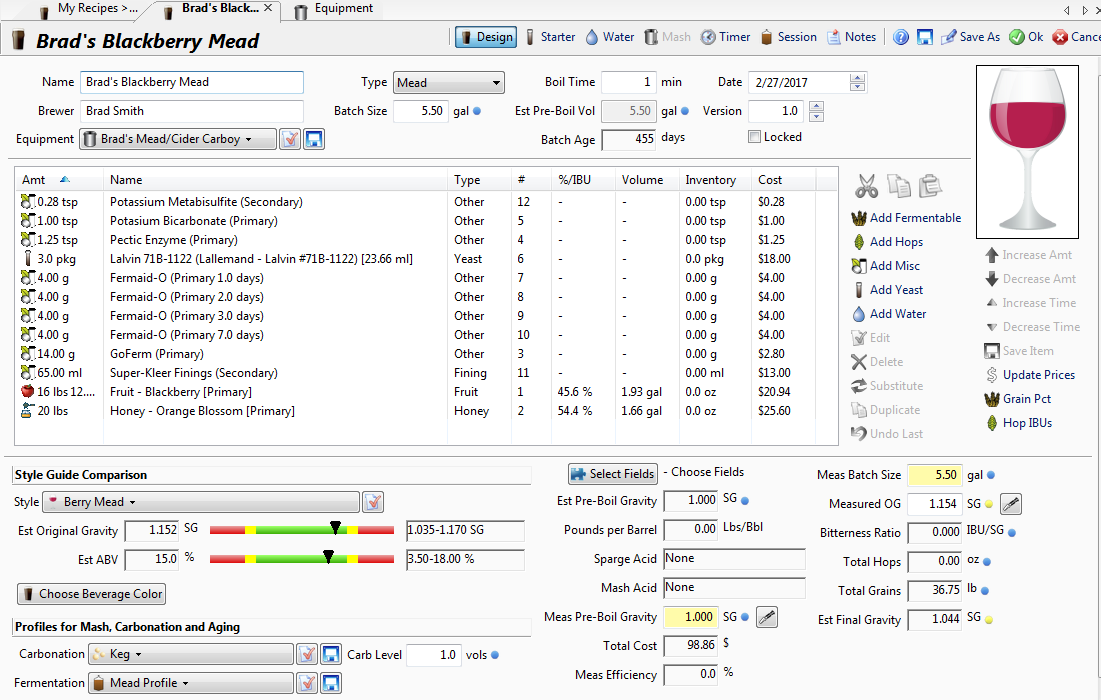
- BEERSMITH RADIO SERIAL
- BEERSMITH RADIO SOFTWARE
- BEERSMITH RADIO CODE
- BEERSMITH RADIO PASSWORD
- BEERSMITH RADIO PC
it will pass to the DHCP server if not static. Enables and select radio type (if attached)
BEERSMITH RADIO SERIAL
Use a bit lower baudrate for serial prints on ESP8266 than default in M圜onfig.h
BEERSMITH RADIO PASSWORD
* Make sure to fill in your ssid and WiFi password below for ssid & pass. * Hardware SHA204 signing is currently not supported! * - Connect GPIO5 via switch to GND ('inclusion switch') * - Connect GPIO0 via 10K resistor to VCC, and via switch to GND ('bootload switch') * - Connect GPIO2 via 10K resistor to VCC * - Connect CH_PD via 10K resistor to VCC * - Connect GPIO15 via 10K pulldown resistor to GND * - Connect REST (reset) via 10K pullup resistor to VCC, and via switch to GND ('reset switch') * The ESP8266 requires a certain pin configuration to download code, and another one to run code:
BEERSMITH RADIO CODE
* This code has been tested on an ESP-12 module. * Not all ESP8266 modules have all pins available on their external interface. * - ERR (red) - fast blink on error during transmission error or recieve crc error

* - TX (yellow) - blink fast on radio message transmitted. In inclusion mode will blink fast only on presentation recieved * - RX (green) - blink fast on radio message recieved. * - To use the feature, uncomment any of the MY_DEFAULT_xx_LED_PINs in your sketch, only the LEDs that is defined is used. If you want to use the defualt values in this sketch enter: 192.168.178.66:5003 This will temporarily override any serial configuration for the Vera plugin. * Enter "ip-number:port" in the ip-field of the Arduino GW device. * The gateway also accepts input on ethernet interface, which is then sent out to the radio network. * The EthernetGateway sends data received from sensors to the WiFi link. * Contribution by Ivo Pullens (ESP8266 support) * Contribution by a-lurker and Anticimex,
BEERSMITH RADIO SOFTWARE
* version 2 as published by the Free Software Foundation. * modify it under the terms of the GNU General Public License * This program is free software you can redistribute it and/or * network topology allowing messages to be routed to nodes. * repeater and gateway builds a routing tables in EEPROM which keeps track of the * The sensors forms a self healing radio network with optional repeaters. * between your home built sensors/actuators and HA controller of choice. * The MySensors Arduino library handles the wireless radio link and protocol * changed version "maindoor" in order to find the right GW in Domoticz and in the router

* disablat inclusion mode (don't know if I had to but I was worried it would interfere with sensor on D3 * changed to #define BUTTON_PIN "D3" instead of only "3" * Pasted code from sketch "BinarySwitchSensor" to get locally connected switch * Doorswitch without NRF24L01 radio, only direct connected doorswitch Or increase the ability to troubleshoot (blinks or whatever?) Hopefully someone can see something in the sketch that can be improved to make it more stable and boot better. Usually it then works OK once I got it going once.Īttached I the sketch, only edited in respect to the SSID and PW. Maybe it doesn’t when I crudely connect it to the charger ? Maybe the answer can be found in the sketch or in the way I set things up ? Sometimes I get it to work due to magic or the phase of the moon and then I don’t touch it. I cannot claim it is a good hypothesis because I have no proof, but I get a feeling it does not boot properly. I look it up in the router and it has not connected and obviously Domoticz doesn’t see it either.
BEERSMITH RADIO PC
Now, when I disconnect from the PC and connect the 8266 to external power, usually a 2.4A USB charger, it blinks once. So far so good, as long as it is booted right after pushing the code, still connected to the PC. At this stage I can also set it up in Domoticz and get sensor readings. I look it up in the router to document the MAC address and IP address and set a fixed IP address in the router.

When done it runs the code and connects to the router. When I push the code, it usually loads without problem an the LED on the 8266 is blinking. I set up the HW ie I attach the sensor to D3 an gnd, solder a short extension antenna to the board and push the code from the Arduino IDE. I have had the problem with a variety of batches of 8266’es, various power sources and a few versions of sketches(albeit very similar). I have several of them working but the rule, and not the exception, is that I have the following problem at setup. I am using the ESP8266 as a GW with sensor (temp/hum or door switch) directly connected to D3. I have problems with my ESP8266 connecting to the router when it is connected to the external power.


 0 kommentar(er)
0 kommentar(er)
